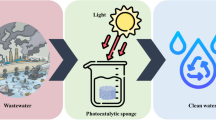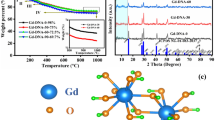Abstract
The water oxidation in alkaline media is a kinetically sluggish process and it requires an active electrocatalyst for overall water splitting which is a challenging task to date. Herein, we formulate a platform for the design of efficient NiCo2S4/C nanocomposite using earth abundant and nonprecious materials. The nanocomposites are prepared by scale up hydrothermal method using different carbon contents from acid dehydrated sucrose. They are structurally and morphologically characterized by various analytic techniques. The scanning electron microscopy has shown few microns flower-like morphology of nanocomposite and hexagonal crystalline phase is identified by X-ray diffraction (XRD). Further, high-resolution transmission electron microscopy supported the XRD results, and C, Ni, Co and O elements were found in the composition nanocomposite as investigated by energy-dispersive spectroscopy. The most active nanocomposite reaches a current density of 20 mA·cm−2 at potential of 285 mV vs reversible hydrogen electrode. The nanocomposite is kinetically supported by 61 mV·dec−1 as small Tafel slope. The nanocomposite is stable and durable for 40 h. The electrochemical impedance spectroscopy described a small charge transfer resistance of 188.4 Ω. These findings suggest that the NiCo2S4/C nanocomposite could be used as a promising material for an extended range of applications particularly in energy technology.






Similar content being viewed by others
Change history
21 August 2021
A Correction to this paper has been published: https://doi.org/10.1007/s42864-021-00115-4
References
Walter MG, Warren EL, McKone JR, Boettcher SW, Mi Q, Santori EA, Lewis NS. Solar water splitting cells. Chem Rev. 2010;110(11):6446.
Salama A. Foundations of environmental physics: understanding energy use and human impacts, by Kyle Forinash. Contemp Phys. 2012;53(1):71.
D' Agosto M de A. Transportation, Energy Use and Environmental Impacts (chapter 5: energy sources for transportation). India: Elsevier. 2019; p. 177.
Kaunda CS, Kimambo CZ, Nielsen TK. Hydropower in the context of sustainable energy supply: a review of technologies and challenges. Int Sch Res Not. 2012;2012:730631.
Zhuang Z, Yuan F, Ye H, Yao J. Study on auxiliary heat sources in solar hot water system in China. Energy Procedia. 2017;142:3.
Dittmar M. Nuclear energy: status and future limitations. Energy. 2012;37(1):35.
Lenzen M. Life cycle energy and greenhouse gas emissions of nuclear energy: a review. Energy Convers Manag. 2008;49(8):2178.
Kumar I, Tyner WE, Sinha KC. Input–output life cycle environmental assessment of greenhouse gas emissions from utility scale wind energy in the United States. Energy Policy. 2016;89:294.
Rivard E, Trudeau M, Zaghib K. Hydrogen storage for mobility: a review. Materials (Basel). 2019;12(12):1973.
Abe JO, Popoola API, Ajenifuja E, Popoola OM. Hydrogen energy, economy and storage: review and recommendation. Int J Hydrogen Energy. 2019;44(29):15072.
Karchiyappan T. A review on hydrogen energy production from electrochemical system: benefits and challenges. Energy Sour Part A Recovery Util Environ Eff. 2019;41(7):902.
Coutanceau C, Baranton S, Audichon T. Chapter 1—hydrogen electrochemical production, hydrogen energy and fuel cells primers. Chennai: Academic Press; 2018. p. 1.
Choi S, Davenport TC, Haile SM. Protonic ceramic electrochemical cells for hydrogen production and electricity generation: exceptional reversibility, stability, and demonstrated faradaic efficiency. Energy Environ Sci. 2019;12(1):206.
Tong Y, Wu J, Chen P, Liu H, Chu W, Wu C, Xie Y. Vibronic superexchange in double perovskite electrocatalyst for efficient electrocatalytic oxygen evolution. J Am Chem Soc. 2018;140(36):11165.
Rong X, Parolin J, Kolpak AM. A Fundamental Relationship between reaction mechanism and stability in metal oxide catalysts for oxygen evolution. ACS Catal. 2016;6(2):1153.
Bockri JO, Otagawa T. Mechanism of oxygen evolution on perovskites. J Phys Chem. 1983;87(15):2960.
Shi Q, Zhu C, Du D, Lin Y. Robust noble metal-based electrocatalysts for oxygen evolution reaction. Chem Soc Rev. 2019;48(12):3181.
Li W, Xiong D, Gao X, Liu L. The oxygen evolution reaction enabled by transition metal phosphide and chalcogenide pre-catalysts with dynamic changes. Chem Commun. 2019;55(60):8744.
Finke CE, Omelchenko ST, Jasper JT, Lichterman MF, Read CG, Lewis NS, Hoffmann MR. Enhancing the activity of oxygen-evolution and chlorine-evolution electrocatalysts by atomic layer deposition of TiO2. Energy Environ Sci. 2019;12(1):358.
Man HW, Tsang CS, Li MMJ, Mo J, Huang B, Lee LYS, Leung YC, Wong KY, Tsang SCE. Tailored transition metal-doped nickel phosphide nanoparticles for the electrochemical oxygen evolution reaction (OER). Chem Commun. 2018;54(62):8630.
Theerthagiri J, Sudha R, Premnath K, Arunachalam P, Madhavan J, Al-Mayouf AM. Growth of iron diselenide nanorods on graphene oxide nanosheets as advanced electrocatalyst for hydrogen evolution reaction. Int J Hydrog Energy. 2017;42(18):13020.
Jin S. Are metal chalcogenides, nitrides, and phosphides oxygen evolution catalysts or bifunctional catalysts? ACS Energy Lett. 2017;2:1937.
Hu X, Zhang S, Sun J, Yu L, Qian X, Hu R, Wang Y, Zhao H, Zhu J. 2D Fe-containing cobalt phosphide/cobalt oxide lateral heterostructure with enhanced activity for oxygen evolution reaction. Nano Energy. 2019;56:109.
Zhang M, Liu Y, Liu B, Chen Z, Xu H, Yan K. Trimetallic NiCoFe-layered double hydroxides nanosheets efficient for oxygen evolution and highly selective oxidation of biomass-derived 5-hydroxymethylfurfural. ACS Catal. 2020;10(9):5179.
Liu Y, Zhang M, Hu D, Li R, Hu K, Yan K. Ar plasma-exfoliated ultrathin NiCo-layered double hydroxide nanosheets for enhanced oxygen evolution. ACS Appl Energy Mater. 2019;2(2):1162.
Li Y, Hasin P, Wu Y. NixCo3-xO4 nanowire arrays for electrocatalytic oxygen evolution. Adv Mater. 2010;22(17):1926.
Gong M, Dai H. A mini review of NiFe-based materials as highly active oxygen evolution reaction electrocatalysts. Nano Res. 2015;8(1):23.
Paulraj AR, Kiros Y, Göthelid M, Johansson MB. NiFeOx as a bifunctional electrocatalyst for oxygen reduction (OR) and evolution (OE) reaction in alkaline media. Catalysts. 2018;8(8):328.
Shin H, Xiao H, Goddard WA. In silico discovery of new dopants for Fe-doped Ni oxyhydroxide (Ni1–xFexOOH) catalysts for oxygen evolution reaction. J Am Chem Soc. 2018;140(22):6745.
Kim JS, Kim B, Kim H, Kang K. Recent progress on multimetal oxide catalysts for the oxygen evolution reaction. Adv Energy Mater. 2017;8(11):1702774.
Xie L, Zhao D, Dai J, Wu Z, Li L. Solvothermally doping NiS2 nanoparticles on carbon with ferric ions for efficient oxygen evolution catalysis. Catalysts. 2019;9(5):458.
Ding J, Ji S, Wang H, Gai H, Liu F, Linkov V, Wang R. Mesoporous nickel-sulfide/nickel/N-doped carbon as HER and OER bifunctional electrocatalyst for water electrolysis. Int J Hydrog Energy. 2019;44(5):2832.
Lu Z, Wang J, Huang S, Hou Y, Li Y, Zhao Y, Mu S, Zhang J, Zhao Y. N, B-codoped defect-rich graphitic carbon nanocages as high performance multifunctional electrocatalysts. Nano Energy. 2017;42:334.
Liu Q, Jin J, Zhang J. NiCo2S4@graphene as a bifunctional electrocatalyst for oxygen reduction and evolution reactions. ACS Appl Mater Interfaces. 2013;5(11):5002.
Fontcuberta I Morral A, Arbiol J, Prades JD, Cirera A, Morante JR. Synthesis of silicon nanowires with Wurtzite crystalline structure by using standard chemical vapor deposition. Adv Mater. 2007;19(10):1347.
Bi Y, Cai Z, Zhou D, Tian Y, Zhang Q, Zhang Q, Kuang Y, Li Y, Sun X, Duan X. Understanding the incorporating effect of Co2+/Co3+ in NiFe-layered double hydroxide for electrocatalytic oxygen evolution reaction. J Catal. 2018;358:100.
Koper MTM. Thermodynamic theory of multi-electron transfer reactions: implications for electrocatalysis. J Electroanal Chem. 2011;660(2):254.
Grimaud A, Diaz-Morales O, Han B, Hong WT, Lee YL, Giordano L, Stoerzinger KA, Koper MTM, Shao-Horn Y. Activating lattice oxygen redox reactions in metal oxides to catalyse oxygen evolution. Nat Chem. 2017;9:457.
Palmas S, Polcaro AM, Ferrara F, Rodriguez Ruiz J, Delogu F, Bonatto-Minella C, Mulas G. Electrochemical performance of mechanically treated SnO2 powders for OER in acid solution. J Appl Electrochem. 2008;38(7):907.
Da Silva LM, De Faria LA, Boodts JFC. Green processes for environmental application. Electrochemical ozone production. Pure Appl Chem. 2001;73(12):1871.
Ollo K, Guillaume PLA, Auguste AFT, Quand-Meme GC, Honoré KK, Ouattara L. Influence of various metallic oxides on the kinetic of the oxygen evolution reaction on platinum electrodes. J Electrochem Sci Eng. 2015;5(2):79.
Aftab U, Tahira A, Mazzaro R, Abro MI, Baloch MM, Willander M, Nur O, Yu C, Ibupoto ZH. The chemically reduced CuO–Co3O4 composite as a highly efficient electrocatalyst for oxygen evolution reaction in alkaline media. Catal Sci Technol. 2019;9(22):6274.
Nivetha R, Kollu P, Chandar K, Pitchaimuthu S, Kwan Jeong S, Nirmala GA. Role of MIL-53(Fe)/hydrated–dehydrated MOF catalyst for electrochemical hydrogen evolution reaction (HER) in alkaline medium and photocatalysis. RSC Adv. 2019;9(6):3215.
Xiang Z, Zhang Z, Xu X, Zhang Q, Yuan C. MoS2 nanosheets array on carbon cloth as a 3D electrode for highly efficient electrochemical hydrogen evolution. Carbon. 2016;98:84.
Su D, Wang J, Jin H, Gong Y, Li M, Pang Z, Wang Y. From, “waste to gold”: a one-pot method to synthesize ultrafinely dispersed Fe2O3-based nanoparticles on N-doped carbon for synergistic and efficient water splitting. J Mater Chem A. 2015;3(22):11756.
Jadhav HS, Roy A, Thorat GM, Chung WJ, Seo JG. Hierarchical free-standing networks of MnCo2S4 as efficient electrocatalyst for oxygen evolution reaction. J Ind Eng Chem. 2019;71:452.
Li Y, Li FM, Meng XY, Li SN, Zeng JH, Chen Y. Ultrathin Co3O4 nanomeshes for the oxygen evolution reaction. ACS Catal. 2018;8(3):1913.
Tan C, Cao J, Khattak AM, Cai F, Jiang B, Yang G, Hu S. High-performance tin oxide-nitrogen doped graphene aerogel hybrids as anode materials for lithium-ion batteries. J Power Sour. 2014;270:28.
Naeem R, Ehsan MA, Yahya R, Sohail M, Khaledi H, Mazhar M. Fabrication of pristine Mn2O3 and Ag–Mn2O3 composite thin films by AACVD for photoelectrochemical water splitting. Dalton Trans. 2016;45(38):14928.
Song Q, Li J, Wang L, Qin Y, Pang L, Liu H. Stable single-atom cobalt as a strong coupling bridge to promote electron transfer and separation in photoelectrocatalysis. J Catal. 2019;370:176.
Acknowledgements
Raffaello Mazzaro and Vittorio Morandi gratefully acknowledge the European Union’s Horizon 2020 research and innovation programme under Graphene Core2 785219-Graphene Flagship for partial funding. We extend our sincere appreciation to the Researchers Supporting Project (No. RSP-2020/79) at King Saud University, Riyadh, Saudi Arabia.
Author information
Authors and Affiliations
Corresponding authors
Additional information
Publisher's Note
Springer Nature remains neutral with regard to jurisdictional claims in published maps and institutional affiliations.
Electronic supplementary material
Below is the link to the electronic supplementary material.
Rights and permissions
About this article
Cite this article
Aftab, U., Tahira, A., Mazzaro, R. et al. Facile NiCo2S4/C nanocomposite: an efficient material for water oxidation. Tungsten 2, 403–410 (2020). https://doi.org/10.1007/s42864-020-00066-2
Received:
Revised:
Accepted:
Published:
Issue Date:
DOI: https://doi.org/10.1007/s42864-020-00066-2




